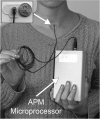Accuracy of Self-Reported Estimates of Daily Voice Use in Adults With Normal and Disordered Voices
- PMID: 27788279
- PMCID: PMC5373697
- DOI: 10.1044/2016_AJSLP-15-0105
Accuracy of Self-Reported Estimates of Daily Voice Use in Adults With Normal and Disordered Voices
Abstract
Purpose: Accurate estimation of daily patterns of vocal behavior is essential to understanding the role of voice use in voice disorders. Given that clinicians currently rely on patient self-report to assess daily vocal behaviors, this study sought to assess the accuracy with which adults with and without voice disorders can estimate their amount of daily voice use in terms of phonation time.
Method: Eighteen subjects (6 patients, 6 matched members of a control group without voice disorders, 6 low voice users) wore the accelerometer-based Ambulatory Phonation Monitor (APM; model 3200, KayPENTAX, Montvale, NJ) for at least 5 workdays. Subjects were instructed to provide hourly self-reports of time spent talking using a visual analog scale. Spearman correlation coefficients and errors between self-reported and APM-based estimates of phonation time revealed subject- and group-specific characteristics.
Results: A majority of subjects exhibited a significant bias toward overestimating their phonation times, with an average absolute error of 113%. Correlation coefficients between self-reported and APM-based estimates of phonation time ranged from statistically nonsignificant to .91, reflecting large intersubject variability.
Conclusions: Subjects in all 3 groups were moderately accurate at estimating their hourly voice use, with a consistent bias toward overestimation. The results support the potential role that ambulatory monitoring could play in improving the clinical assessment of voice disorders.
Figures


References
-
- Airo E., Olkinuora P., & Sala E. (2000). A method to measure speaking time and speech sound pressure level. Folia Phoniatrica et Logopaedica, 52, 275–288. - PubMed
-
- Buekers R., Bierens E., Kingma H., & Marres E. H. M. A. (1995). Vocal load as measured by the voice accumulator. Folia Phoniatrica et Logopaedica, 47, 252–261. - PubMed
-
- Cheyne H. A., Hanson H. M., Genereux R. P., Stevens K. N., & Hillman R. E. (2003). Development and testing of a Portable Vocal Accumulator. Journal of Speech, Language, and Hearing Research, 46, 1457–1467. - PubMed
-
- Fant G., Kruckenberg A., & Nord L. (1991). Prosodic and segmental speaker variations. Speech Communication, 10, 521–531.
-
- Hillman R. E., Heaton J. T., Masaki A., Zeitels S. M., & Cheyne H. A. (2006). Ambulatory monitoring of disordered voices. Annals of Otology, Rhinology & Laryngology, 115, 795–801. - PubMed
MeSH terms
Grants and funding
LinkOut - more resources
Full Text Sources
Other Literature Sources
Medical

